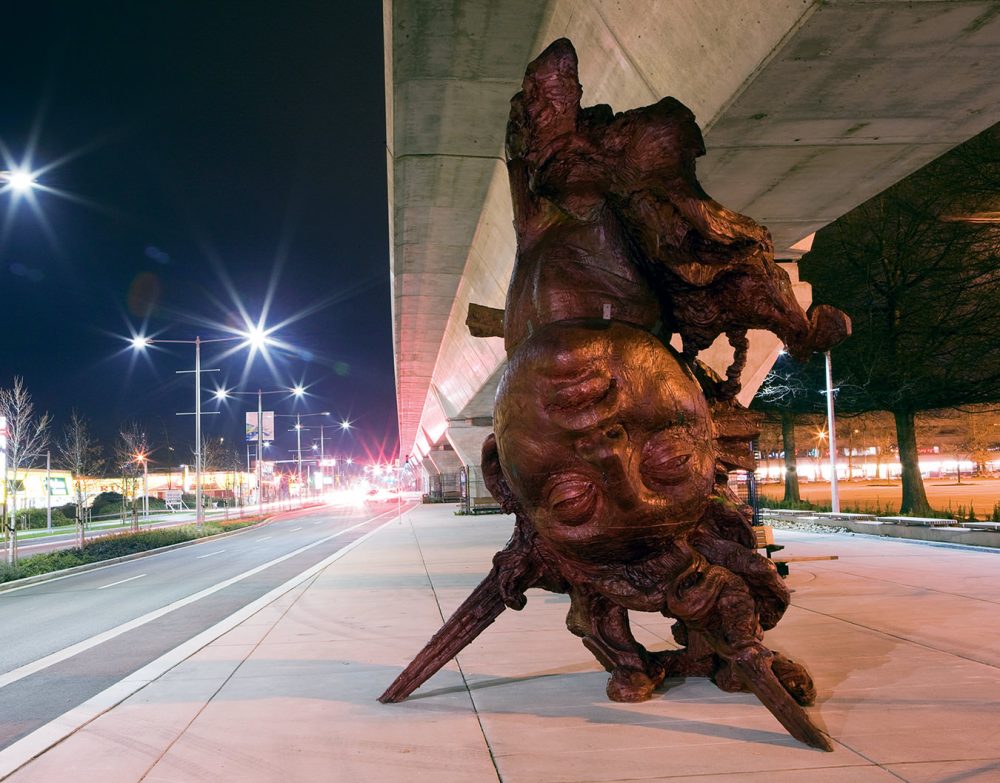Consumed as I was with the dense traffic in Richmond one day, my preschooler’s urgent cry initially caused me a moment of trouble and confusion: “Mama, look at the tumbling heads!” I realized she was pointing at the grouping of elegantly dynamic heads with baroque beards and blown locks, solemnly topsy-turvy—Cabeza Vainilla, Cabeza Córdoba, Cabeza Chiapas (2008–2009), Javier Marin’s stunning contribution to the Vancouver Biennale 2009–2011 public art exhibition.
Early manifestations of public art were memorials, behemoths feting victories of warfare or commemorating leaders—the Luxor Obelisk in Paris’s Place de la Concorde, for example. Today, public art’s relevance is manifold. From municipally commissioned memorials in small-town B.C. to surreptitious guerrilla graffiti on London’s streets, public art is a vehicle for, commentary on, and reflection of social, political, and cultural experience and change. It beautifies and invigorates a space; it can represent the spirit of a community; it can commemorate a point in time; it can challenge you to think differently about the world that is around you.
Who chooses, makes, and pays for public works, such as the iconic and colloquially named “Bean”, the leguminous stainless steel sculpture Cloud Gate (2004–2006), by Anish Kapoor in Chicago’s Millennium Park? Most municipalities have a public art program, which funds works with either an annually allocated budget for civic projects or by a Percent for Art policy. For example, the City of Vancouver’s Private Sector Development Program mandates that private sector rezonings over 100,000 square feet must commit $1.81 per buildable square foot to a public art process approved by the city. Typically, artworks are selected by way of a call for artist submissions which then go through a juried selection process. Alternatively, works can be funded partly (or wholly) by private donation, as was the case with Chicago’s “Bean”. In yet a further instance, as with the notoriously clandestine Banksy, a politicized graffiti artist in London, public art can be imposed, unauthorized, powerful, and fleeting.
It can also be controversial. Richard Serra’s Tilted Arc (1981), a 36.6-metre-long steel arc that bisected Federal Plaza in New York city, forced people working in the vicinity to circumambulate the enormous sculpture. Serra intended to challenge people’s notion of space. It elicited considerable complaints, and after a public hearing, it was to be removed. Serra protested, insisting the work was site-specific and that “to remove the work is to destroy it,” but the piece eventually met its fate when it was finally dismantled in 1989.
Artworks in public spaces aren’t always of gargantuan proportions, however. Tracey Emin’s subtle Baby Things (2008) is a scattering of delicate, bronzed baby clothes—tiny booties, a knit sweater, mittens—placed throughout Folkestone, U.K. It was Emin’s poignant response to the high rate of teenage pregnancy in the vicinity.
Public art takes forms permanent and temporal, interactive and performance-based. New York’s The Gates (2005), a sinuous maze of orange frames with draping saffron-coloured fabric created by renowned duo Christo and Jeanne-Claude, was installed in Central Park for merely two weeks, though it took 26 years to conceive. In Canada, the newly installed Promenade (2012) by Londoner Julian Opie, is a 7.3-metre-tall LED tower overlooking the undeveloped downtown of Calgary’s East Village. The screen shows minimally rendered pedestrians circling the tower at different speeds, occasionally overtaking each other. Unique in that it precedes any urban development, this dynamic artwork sets the stage for what is hoped to be a culturally rich neighbourhood.
Key to place-making, public art informs a city, and in turn is informed by the city. It can enhance, even help to build, a community identity. Any Vancouverite driving through East Vancouver is well familiar with Ken Lum’s illuminated cross raised high above the skyline, proclaiming “EAST VAN”, the words intersecting at the letter A. An assertion of identity, Monument for East Vancouver (2010) employs a symbol that has been used for decades to represent the area. Looking to Vancouver’s Southeast False Creek Olympic Plaza, one sees two elephantine sculptures of house sparrows. Commissioned by the city’s Olympic and Paralympic Public Art Program, The Birds (2010) by Myfanwy MacLeod was named one of North America’s 47 best public artworks in 2011 by Americans for the Arts. These oversized denizens of the so-called natural world (they are in fact a non-native species introduced to North America by the English in the 19th century) placed in an urban environment raises questions about sustainability and environmental responsibility—concepts that, as Vancouverites, we pride ourselves upon.
Permanent or transitory, interactive or stationary, overwhelming or subtle, public art actively shapes and is shaped by communities and its citizens, no matter their age.









